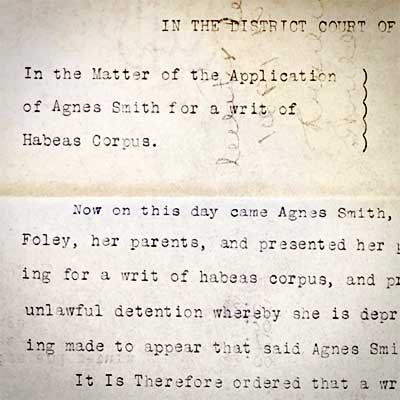
On March 24th, 1921, Agnes Smith’s mother and step-father, Mary and Thomas Foley, filed a petition for habeas corpus on her behalf. The Foleys alleged that Agnes was unlawfully detained at the Institute for Feeble-Minded Youth in Beatrice, NE, under the orders of Superintendent S. J. Stewart. The Foleys explained that in 1914, sixteen-year-old Agnes was committed to the Girl’s Industrial School by the Juvenile Court of Douglas County (Omaha, NE) for unclear causes. Agnes received a two-year commitment, but she remained at the Industrial School for five years and then officials committed Agnes to the Institute for Feeble-Minded Youth against her will and without the consent of her parents. The Foleys asserted that their daughter was not feeble-minded, and they wished for Agnes to be released. Although the judge initially granted the Foley’s petition, the Institute’s counsel had the case dismissed due to jurisdictional concerns as Agnes was detained in Gage County and her parents petitioned from Douglas County.[1]
Newspaper coverage of the case revealed that Agnes’ parents continued to fight for their daughter. Mary Foley vowed that she and her husband would fight to the end to get Agnes out of the Institute and they filed a second petition a few months later in Gage County, just under one hundred miles from their Omaha home.[2] The writ was not allowed, as the judge in Beatrice decided that Agnes was a “fit and proper subject” for the Institute for Feeble-Minded Youth.[3] Newspapers indicate that Superintendent S. J. Stewart characterized twenty-one-year-old Agnes as having “the mentality of an eight year old” and thus required the custodial care of the institute.[4]
Agnes faced institutionalization at the same time eugenic sterilization emerged in Nebraska. The rise of eugenic thought in the United States in the early-twentieth century permeated the Institute for Feeble-Minded Youth and similar institutions in Nebraska, which passed its sterilization law in 1915, the year after Agnes entered the Girls’ School in Geneva. The sterilization law stated that:
Hereafter no feeble-minded, or insane inmate, physically capable of bearing or begetting offspring, shall be paroled or discharged from the institution for the feeble-minded, or the hospitals for the insane, nor paroled from the penitentiary, reformatory, industrial home, industrial schools or other such state institution, except as hereinafter provided, or by order of a court of competent jurisdiction.[5]
The sterilization statute explains why Agnes was not released from the Girls’ Industrial School, which focused on the “retention, education, discipline, industrial training, and reformation of female juvenile delinquents.”[6] Laws governing the Boys’ School applied to the Girls’ School, including the provision allowing for the transfer of “feeble-minded inmates” to the Institute for Feeble-Minded Youth.[7] This meant that even though Agnes’ transfer was not consensual, as her habeas proceedings indicate, it was legal. What should have been two years of juvenile detention had become a eugenic institutionalization that seemingly had no end in sight.
Nebraska’s Board of Examiners of Defectives endorsed a policy that required sterilization as a condition of parole for those classed as feeble-minded.[8] Because parole applicants could “choose” sterilization as a route to freedom, Nebraska’s sterilization law has been classified as non-compulsory despite its explicitly coercive conditions.[9] Members of the Board expressed concerns that paroled women may nonetheless engage in prostitution and other forms of sexual deviance, arguing that even sterilized women should remain institutionalized long term.[10]
Whether Agnes was sterilized, we do not know. First institutionalized at age sixteen in 1914, Agnes spent at least another sixteen years in Nebraska state institutions. Although her parents petitioned for her freedom in 1921, Agnes remained in the Nebraska Institution for the Feeble-Minded at least as late as 1930 when she turned thirty-two, and we do not know more about her ordeal after that date, but her petition marks an important protest to compulsory institutionalization under a eugenic state.[11]
- [1] “In the matter of the application of Agnes Smith for a writ of habeas corpus," in Petitioning for Freedom: Habeas Corpus in the American West, 1812-1924, edited by Katrina Jagodinsky, et al. University of Nebraska–Lincoln. Accessed July 2023. https://petitioningforfreedom.unl.edu/cases/item/hc.case.ne.1335.
- [2] Head of Asylum Blocks Move to Free Omaha Girl, Omaha Daily Bee, March 27, 1921, Chronicling America: Historic American Newspapers, Lib. of Congress. https://chroniclingamerica.loc.gov/lccn/sn99021999/1921-03-27/ed-1/seq-5/
- [3] “In the matter of the application of Agnes Smith for a writ of habeas corpus," in Petitioning for Freedom: Habeas Corpus in the American West, 1812-1924, edited by Katrina Jagodinsky, et al. University of Nebraska–Lincoln. Accessed July 2023. https://petitioningforfreedom.unl.edu/cases/item/hc.case.ne.1568
- [4] Seeks Release of Inmate of Institution, Beatrice Daily Sun, May 03, 1921.
- [5] Neb. Rev. Stat. § 66 –157059 (1922)
- [6] Neb. Rev. Stat. § 66 -127041 (1922)
- [7] Neb. Rev. Stat. § 66 -117040 (1922)
- [8] Neb. Rev. Stat. § 66 –157062 (1922)
- [9] “Eugenics: Compulsory Sterilization in 50 American States.” Accessed July 28, 2023. https://www.uvm.edu/~lkaelber/eugenics/.
- [10] Board of Control of Nebraska, “Second Biennial Report of the Board of Commissions of State Institutions,” Biennial Reports of the Board of Commissions of State Institutions (State of Nebraska, 1916), https://catalog.hathitrust.org/Record/008686229.
- [11] "United States Census, 1930," database with images, FamilySearch (https://familysearch.org/ark:/61903/3:1:33S7-9RCF-DCN?cc=1810731&wc=QZF7-Z98%3A648805601%2C650117601%2C648935201%2C1589282525 : 8 December 2015), Nebraska > Gage > Midland > ED 36 > image 16 of 20; citing NARA microfilm publication T626 (Washington D.C.: National Archives and Records Administration, 2002). Agnes spent 5 years at the Industrial School, and spent at least 11 years at the Institute for Feeble-Minded Youth. 1930 census records reveal her to have still been an “inmate” there in 1930.

